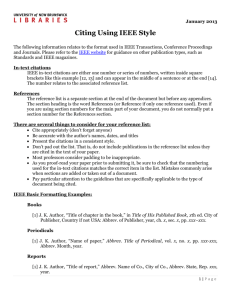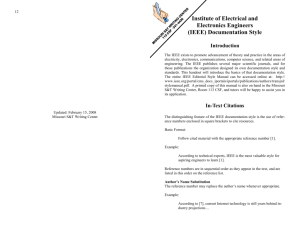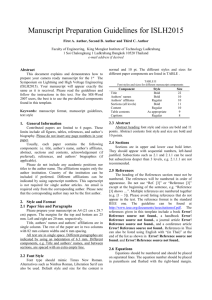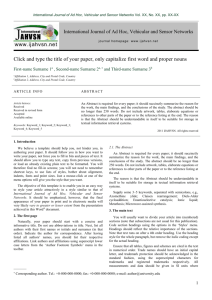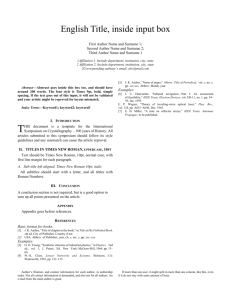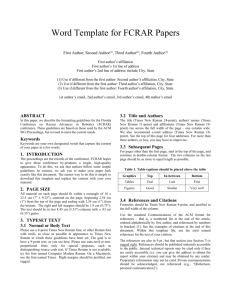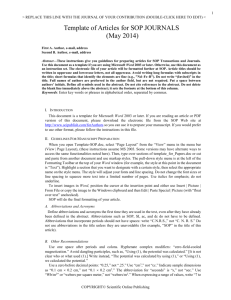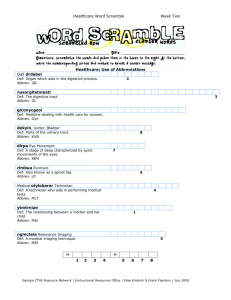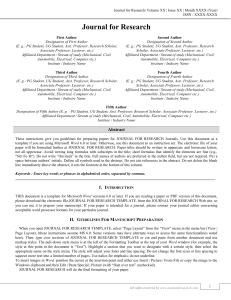Sample Paper Format
advertisement
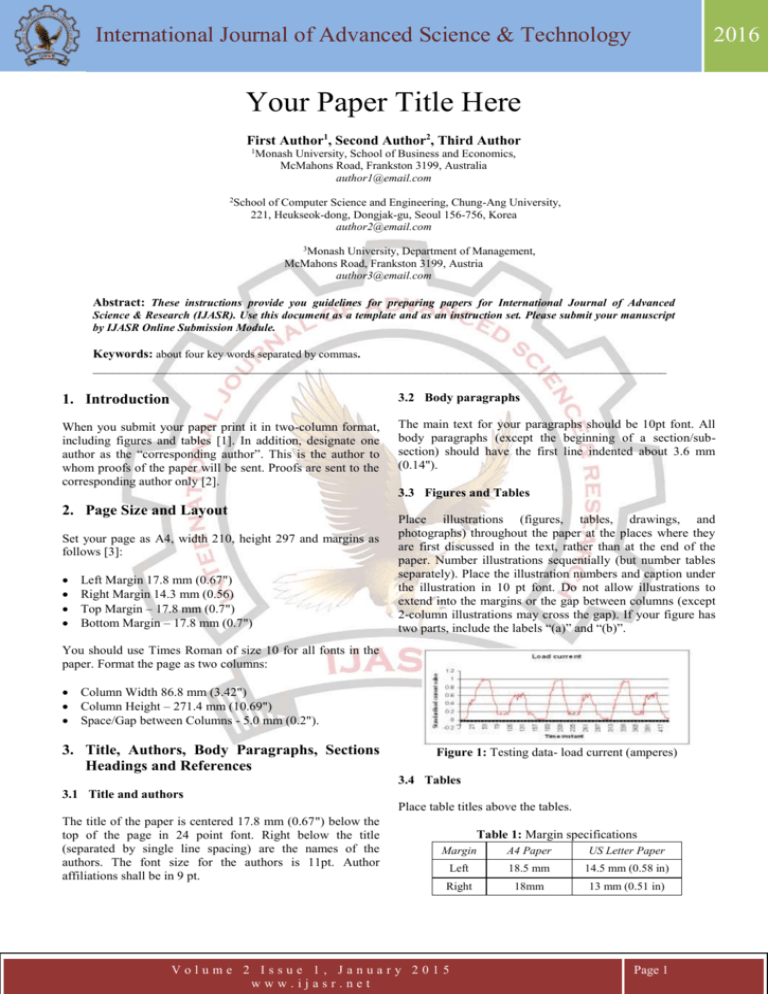
International Journal of Advanced Science & Technology 2016 Your Paper Title Here First Author1, Second Author2, Third Author 1Monash University, School of Business and Economics, McMahons Road, Frankston 3199, Australia author1@email.com 2School of Computer Science and Engineering, Chung-Ang University, 221, Heukseok-dong, Dongjak-gu, Seoul 156-756, Korea author2@email.com 3Monash University, Department of Management, McMahons Road, Frankston 3199, Austria author3@email.com Abstract: These instructions provide you guidelines for preparing papers for International Journal of Advanced Science & Research (IJASR). Use this document as a template and as an instruction set. Please submit your manuscript by IJASR Online Submission Module. Keywords: about four key words separated by commas. _________________________________________________________________________________________ 1. Introduction 3.2 Body paragraphs When you submit your paper print it in two-column format, including figures and tables [1]. In addition, designate one author as the “corresponding author”. This is the author to whom proofs of the paper will be sent. Proofs are sent to the corresponding author only [2]. The main text for your paragraphs should be 10pt font. All body paragraphs (except the beginning of a section/subsection) should have the first line indented about 3.6 mm (0.14"). 3.3 Figures and Tables 2. Page Size and Layout Set your page as A4, width 210, height 297 and margins as follows [3]: Left Margin 17.8 mm (0.67") Right Margin 14.3 mm (0.56) Top Margin – 17.8 mm (0.7") Bottom Margin – 17.8 mm (0.7") Place illustrations (figures, tables, drawings, and photographs) throughout the paper at the places where they are first discussed in the text, rather than at the end of the paper. Number illustrations sequentially (but number tables separately). Place the illustration numbers and caption under the illustration in 10 pt font. Do not allow illustrations to extend into the margins or the gap between columns (except 2-column illustrations may cross the gap). If your figure has two parts, include the labels “(a)” and “(b)”. You should use Times Roman of size 10 for all fonts in the paper. Format the page as two columns: Column Width 86.8 mm (3.42") Column Height – 271.4 mm (10.69") Space/Gap between Columns - 5.0 mm (0.2"). 3. Title, Authors, Body Paragraphs, Sections Headings and References Figure 1: Testing data- load current (amperes) 3.4 Tables 3.1 Title and authors Place table titles above the tables. The title of the paper is centered 17.8 mm (0.67") below the top of the page in 24 point font. Right below the title (separated by single line spacing) are the names of the authors. The font size for the authors is 11pt. Author affiliations shall be in 9 pt. Table 1: Margin specifications Margin A4 Paper US Letter Paper Left 18.5 mm 14.5 mm (0.58 in) Right 18mm 13 mm (0.51 in) Volume 2 Issue 1, January 2015 www.ijasr.net Page 1 International Journal of Advanced Science & Technology [6] 3.5 Sections headings [7] Section headings come in several varieties: 1. first level headings: 1. Heading 1 2. second level: 1.2. Heading 2 3. third level: 1.2.3 Heading 3 4. forth level: (a) Heading 4 5. fifth level: (1) Heading 5 [8] 2016 J. U. Duncombe, “Infrared navigation—Part I: An assessment of feasibility,” IEEE Trans. Electron Devices, vol. ED-11, no. 1, pp. 34–39, Jan. 1959. E. P. Wigner, “Theory of traveling-wave optical laser,” Phys. Rev., vol. 134, pp. A635–A646, Dec. 1965. E. H. Miller, “A note on reflector arrays,” IEEE Trans. Antennas Propagat., to be published. Basic format for reports: [9] J. K. Author, “Title of report,” Abbrev. Name of Co., City of Co., Abbrev. State, Rep. xxx, year. Examples: 3.6 References Number citations consecutively in square brackets [1]. The sentence punctuation follows the brackets [2]. Multiple references [2], [3] are each numbered with separate brackets [1]–[3]. Please note that the references at the end of this document are in the preferred referencing style. Please ensure that the provided references are complete with all the details and also cited inside the manuscript (example: page numbers, year of publication, publisher’s name etc.). 4. Equations If you are using Word, use either the Microsoft Equation Editor or the MathType add-on (http://www.mathtype.com) for equations in your paper (Insert | Object | Create New | Microsoft Equation or MathType Equation). “Float over text” should not be selected. Number equations consecutively with equation numbers in parentheses flush with the right margin, as in (1). First use the equation editor to create the equation. Then select the “Equation” markup style. Press the tab key and write the equation number in parentheses. P K E ( opk )2 p 1 k 1 (1) 5. Other recommendations Equalize the length of your columns on the last page. If you are using Word, proceed as follows: Insert/Break/Continuous. REFERENCES Basic format for books: J. K. Author, “Title of chapter in the book,” in Title of His Published Book, xth ed. City of Publisher, Country if not [2] USA: Abbrev. of Publisher, year, ch. x, sec. x, pp. xxx–xxx. [1] Examples: [3] [4] G. O. Young, “Synthetic structure of industrial plastics,” in Plastics, 2nd ed., vol. 3, J. Peters, Ed. New York: McGraw-Hill, 1964, pp. 15–64. W.-K. Chen, Linear Networks and Systems. Belmont, CA: Wadsworth, 1993, pp. 123–135. Basic format for periodicals: [5] J. K. Author, “Name of paper,” Abbrev. Title of Periodical, vol. x, no. x, pp. xxx-xxx, Abbrev. Month, year. Examples: [10] E. E. Reber, R. L. Michell, and C. J. Carter, “Oxygen absorption in the earth’s atmosphere,” Aerospace Corp., Los Angeles, CA, Tech. Rep. TR-0200 (4230-46)-3, Nov. 1988. [11] J. H. Davis and J. R. Cogdell, “Calibration program for the 16-foot antenna,” Elect. Eng. Res. Lab., Univ. Texas, Austin, Tech. Memo. NGL-006-69-3, Nov. 15, 1987. Basic format for handbooks: [12] Name of Manual/Handbook, x ed., Abbrev. Name of Co., City of Co., Abbrev. State, year, pp. xxx-xxx. Examples: [13] Transmission Systems for Communications, 3rd ed., Western Electric Co., Winston-Salem, NC, 1985, pp. 44–60. [14] Motorola Semiconductor Data Manual, Motorola Semiconductor Products Inc., Phoenix, AZ, 1989. Basic format for books (when available online): [15] Author. (year, month day). Title. (edition) [Type of medium]. volume (issue). Available: site/path/file Example: [16] J. Jones. (1991, May 10). Networks. (2nd ed.) [Online]. Available: http://www.atm.com Basic format for journals (when available online): [17] Author. (year, month). Title. Journal. [Type of medium]. volume (issue), pages. Available: site/path/file Example: [18] R. J. Vidmar. (1992, Aug.). On the use of atmospheric plasmas as electromagnetic reflectors. IEEE Trans. Plasma Sci. [Online]. 21(3), pp. 876–880. Available: http://www.halcyon.com/pub/journals/21ps03-vidmar Basic format for papers presented at conferences (when available online): [19] Author. (year, month). Title. Presented at Conference title. [Type of Medium]. Available: site/path/file Example: [20] PROCESS Corp., MA. Intranets: Internet technologies deployed behind the firewall for corporate productivity. Presented at INET96 Annual Meeting. [Online]. Available: http://home.process.com/Intranets/wp2.htp Basic format for reports online): and handbooks (when available [21] Author. (year, month). Title. Comp an y . C ity, State or Country. [Type of Medium].Available: site/path/file Example: [22] S. L. Tall een . (1996 , Apr . ). Th e In t r an et Archi te c tu r e : M a n a g i n g i n f o r m a t i o n i n t h e n e w paradigm. Amdahl Corp., CA. [Online]. Available: http://www.amdahl.com/doc/products/bsg/intra/infra/html Basic format for computer programs and electronic documents (when available online): ISO recommends that capitalization follow the accepted practice for the language or script in which the information is given. Example: Volume 2 Issue 1, January 2015 www.ijasr.net Page 2 International Journal of Advanced Science & Technology [23] A. Harriman. (1993, June). Compendium of genealogical software. Humanist. [Online]. Available e-mail: HUMANIST@NYVM.ORG Message: get GENEALOGY REPORT Basic format for patents (when available online): [24] Name of the invention, by inventor’s name. (year, month day). Patent Number [Type of medium]. Available: site/path/file Example: [25] Musical toothbrush with adjustable neck and mirror, by L.M.R. Brooks. (1992, May 19). Patent D 326 189 [Online]. Available: NEXIS Library: LEXPAT File: DESIGN Basic format for conference proceedings (published): [26] J. K. Author, “Title of paper,” in Abbreviated Name of Conf., City of Conf., Abbrev. State (if given), year, pp. xxxxxx. Example: [27] D. B. Payne and J. R. Stern, “Wavelength-switched pas- sively coupled single-mode optical network,” in Proc. IOOC-ECOC, 1985, pp. 585–590. Example for papers presented at conferences (unpublished): [28] D. Ebehard and E. Voges, “Digital single sideband detection for interferometric sensors,” presented at the 2nd Int. Conf. Optical Fiber Sensors, Stuttgart, Germany, Jan. 2-5, 1984. Basic format for patents: [29] J. K. Author, “Title of patent,” U.S. Patent x xxx xxx, Abbrev. Month, day, year. Example: [30] G. Brandli and M. Dick, “Alternating current fed power supply,” U.S. Patent 4 084 217, Nov. 4, 1978. Basic format for theses (M.S.) and dissertations (Ph.D.): [31] J. K. Author, “Title of thesis,” M.S. thesis, Abbrev. Dept., Abbrev. Univ., City of Univ., Abbrev. State, year. [32] J. K. Author, “Title of dissertation,” Ph.D. dissertation, Abbrev. Dept., Abbrev. Univ., City of Univ., Abbrev. State, year. Fellow (F) in 1987. The first paragraph may contain a place and/or date of birth (list place, then date). Next, the author’s educational background is listed. The degrees should be listed with type of degree in what field, which institution, city, state, and country, and year the degree was earned. The author’s major field of study should be lower-cased. The second paragraph uses the pronoun of the person (he or she) and not the author’s last name. It lists military and work experience, including summer and fellowship jobs. Job titles are capitalized. The current job must have a location; previous positions may be listed without one. Information concerning previous publications may be included. Try not to list more than three books or published articles. The format for listing publishers of a book within the biography is: title of book (city, state: publisher name, year) similar to a reference. Current and previous research interests end the paragraph. The third paragraph begins with the author’s title and last name (e.g., Dr. Smith, Prof. Jones, Mr. Kajor, Ms. Hunter). List any memberships in professional societies other than the IEEE. Finally, list any awards and work for IEEE committees and publications. If a photograph is provided, the biography will be indented around it. The photograph is placed at the top left of the biography, and should be of good quality, professional-looking, and black and white (see above example). Personal hobbies will be deleted from the biography. Following are two examples of an author’s biography. Second B. Author was born in Greenwich Village, New York City, in 1977. He received the B.S. and M.S. degrees in aerospace engineering from the University of Virginia, Charlottesville, in 2001 and the Ph.D. degree in mechanical engineering from Drexel University, Philadelphia, PA, in Examples: [33] J. O. Williams, “Narrow-band analyzer,” Ph.D. dissertation, Dept. Elect. Eng., Harvard Univ., Cambridge, MA, 1993. [34] N. Kawasaki, “Parametric study of thermal and chemical nonequilibrium nozzle flow,” M.S. thesis, Dept. Electron. Eng., Osaka Univ., Osaka, Japan, 1993. Basic format for the most common types of unpublished references: [35] J. K. Author, private communication, Abbrev. Month, year. [36] J. K. Author, “Title of paper,” unpublished. [37] J. K. Author, “Title of paper,” to be published. Examples: [38] A. Harrison, private communication, May 1995. [39] B. Smith, “An approach to graphs of linear forms,” unpublished. [40] A. Brahms, “Representation error for real numbers in binary computer arithmetic,” IEEE Computer Group Repository, Paper R-67-85. Basic format for standards: [41] Title of Standard, Standard number, date. Examples: [42] IEEE Criteria for Class IE Electric Systems, IEEE Standard 308, 1969. [43] Letter Symbols for Quantities, ANSI Standard Y10.5-1968. Author Profile First A. Author (M’76–SM’81–F’87) and the other authors may include biographies at the end of regular papers. Biographies are often not included in conference-related papers. This author became a Member (M) of IEEE in 1976, a Senior Member (SM) in 1981, and a 2016 2008. From 2001 to 2004, he was a Research Assistant with the Princeton Plasma Physics Laboratory. Since 2009, he has been an Assistant Professor with the Mechanical Engineering Department, Texas A&M University, College Station. He is the author of three books, more than 150 articles, and more than 70 inventions. His research interests include highpressure and high-density nonthermal plasma discharge processes and applications, microscale plasma discharges, discharges in liquids, spectroscopic diagnostics, plasma propulsion, and innovation plasma applications. He is an Associate Editor of the journal Earth, Moon, Planets, and holds two patents. Mr. Author was a recipient of the International Association of Geomagnetism and Aeronomy Young Scientist Award for Excellence in 2008, the IEEE Electromagnetic Compatibility Society Best Symposium Paper Award in 2011, and the American Geophysical Union Outstanding Student Paper Award in Fall 2005. Volume 2 Issue 1, January 2015 www.ijasr.net Page 3 International Journal of Advanced Science & Technology 2016 Third C. Author, Jr. (M’87) received the B.S. degree in mechanical engineering from National Chung Cheng University, Chiayi, Taiwan, in 2004 and the M.S. degree in mechanical engineering from National Tsing Hua University, Hsinchu, Taiwan, in 2006. He is currently pursuing the Ph.D. degree in mechanical engineering at Texas A&M University, College Station. From 2008 to 2009, he was a Research Assistant with the Institute of Physics, Academia Sinica, Tapei, Taiwan. His research interest includes the development of surface processing and biological/medical treatment techniques using nonthermal atmospheric pressure plasmas, fundamental study of plasma sources, and fabrication of micro- or nanostructured surfaces. Mr. Author’s awards and honors include the Frew Fellowship (Australian Academy of Science), the I. I. Rabi Prize (APS), the European Frequency and Time Forum Award, the Carl Zeiss Research Award, the William F. Meggers Award and the Adolph Lomb Medal (OSA). Volume 2 Issue 1, January 2015 www.ijasr.net Page 4
